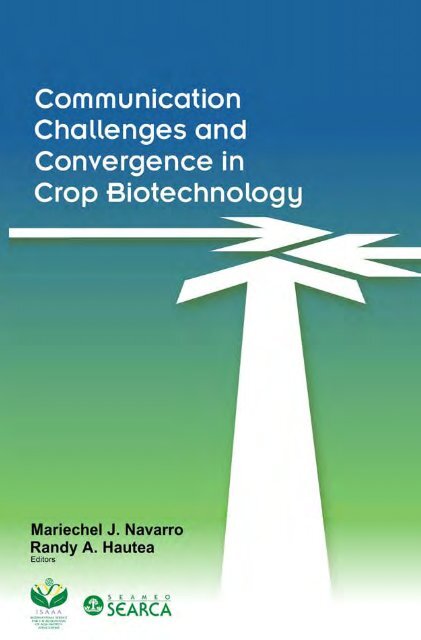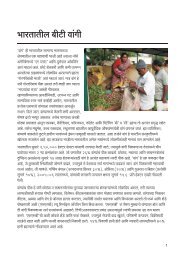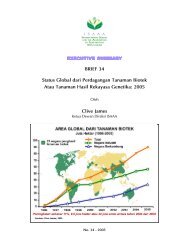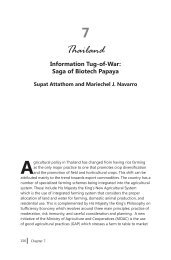Communication Challenges and Convergence in Crop ... - isaaa
Communication Challenges and Convergence in Crop ... - isaaa
Communication Challenges and Convergence in Crop ... - isaaa
Create successful ePaper yourself
Turn your PDF publications into a flip-book with our unique Google optimized e-Paper software.
<strong>Communication</strong><br />
<strong>Challenges</strong> <strong>and</strong> <strong>Convergence</strong><br />
<strong>in</strong> <strong>Crop</strong> Biotechnology<br />
Mariechel J. Navarro<br />
R<strong>and</strong>y A. Hautea<br />
Editors<br />
1
Published by: The International Service for the Acquisition of Agri-biotech Applications<br />
(ISAAA) <strong>and</strong> SEAMEO Southeast Asian Regional Center for Graduate<br />
Study <strong>and</strong> Research <strong>in</strong> Agriculture (SEARCA)<br />
Citation: Navarro, Mariechel J. <strong>and</strong> R<strong>and</strong>y A. Hautea. 2011. <strong>Communication</strong><br />
<strong>Challenges</strong> <strong>and</strong> <strong>Convergence</strong> <strong>in</strong> <strong>Crop</strong> Biotechnology. International<br />
Service for the Acquisition of Agri-biotech Applications (ISAAA): Ithaca,<br />
New York <strong>and</strong> SEAMEO Southeast Asian Regional Center for Graduate<br />
Study <strong>and</strong> Research <strong>in</strong> Agriculture (SEARCA): Los Baños, Philipp<strong>in</strong>es.<br />
ISBN: 978-1-892456-50-8<br />
©2011 ISAAA <strong>and</strong> SEARCA<br />
All rights reserved. Except for brief quotations <strong>in</strong> a review, this book, or parts thereof, must<br />
not be reproduced, stored <strong>in</strong> a retrieval system or transmitted <strong>in</strong> any form or by any means,<br />
electronic, mechanical, photocopy<strong>in</strong>g, record<strong>in</strong>g, duplicat<strong>in</strong>g or otherwise, without prior<br />
permission <strong>in</strong> writ<strong>in</strong>g of the publisher <strong>and</strong> copyright owner.<br />
2
Contents<br />
Preface iii<br />
Acknowledgments v<br />
Contributors vi<br />
Acronyms ix<br />
Part I <strong>Crop</strong> Biotechnology <strong>and</strong> Science <strong>Communication</strong><br />
1 Global Scenario for <strong>Crop</strong> Biotechnology:<br />
<strong>Communication</strong> Sett<strong>in</strong>g<br />
Von V. Mark Cruz <strong>and</strong> R<strong>and</strong>y A. Hautea<br />
2 Science <strong>Communication</strong>: Build<strong>in</strong>g Consensus on<br />
<strong>Crop</strong> Biotechnology<br />
Mariechel J. Navarro<br />
Part II Case Studies of <strong>Communication</strong> Initiatives <strong>in</strong><br />
Biotech Countries<br />
3 Philipp<strong>in</strong>es<br />
Drama <strong>and</strong> <strong>Communication</strong> Beh<strong>in</strong>d Asia’s First Commercialized<br />
Bt Corn<br />
Jenny A. Panopio <strong>and</strong> Mariechel J. Navarro<br />
4 India<br />
Biotech Science <strong>Communication</strong>: Bridg<strong>in</strong>g Science <strong>and</strong> Society<br />
Bhagirath Choudhary <strong>and</strong> Kadamb<strong>in</strong>i Gaur<br />
5 Ch<strong>in</strong>a<br />
Beyond Technology: Populariz<strong>in</strong>g Genetic Modification<br />
Huang Dafang, Zhang Tian, Yue Tongq<strong>in</strong>g, <strong>and</strong> Zhang<br />
Hongxiang<br />
6 Australia<br />
Underst<strong>and</strong><strong>in</strong>g the Target Audience for Better <strong>Communication</strong><br />
Craig Cormick<br />
Part III Case Studies of <strong>Communication</strong> Initiatives <strong>in</strong><br />
Potential Biotech Countries<br />
7 Thail<strong>and</strong><br />
Information Tug-of-War: Saga of Biotech Papaya<br />
Supat Attathom <strong>and</strong> Mariechel J. Navarro<br />
1<br />
26<br />
43<br />
81<br />
112<br />
131<br />
156<br />
i
ii<br />
8 Malaysia<br />
Biotechnology Awareness: From the Ivory Towers to<br />
the Masses<br />
Mahaletchumy Arujanan<br />
9 Bangladesh<br />
Contribution of Science <strong>Communication</strong> to Biotech <strong>Crop</strong><br />
Commercialization<br />
Khondoker Nasirudd<strong>in</strong><br />
10 Vietnam<br />
Pav<strong>in</strong>g the Way for Greater Awareness <strong>and</strong> Underst<strong>and</strong><strong>in</strong>g of<br />
Biotechnology<br />
Hien Le <strong>and</strong> Mariechel J. Navarro<br />
Part IV Regional Initiatives on Biotech Science <strong>Communication</strong><br />
11 Initiat<strong>in</strong>g Science <strong>Communication</strong> <strong>in</strong> the Organization of<br />
Islamic Conference Countries<br />
Muhammad Iqbal Choudhary <strong>and</strong> Sammer Yousuf<br />
12 Knowledge Shar<strong>in</strong>g <strong>and</strong> Exchange <strong>in</strong> Plant Biotechnology:<br />
Experiences from the Plant Science Industry<br />
Sonny P. Tababa <strong>and</strong> Siang Hee Tan<br />
Part V Synthesis<br />
Index<br />
13 <strong>Convergence</strong> <strong>in</strong> Science <strong>Communication</strong>: The Tipp<strong>in</strong>g Po<strong>in</strong>t<br />
Mariechel J. Navarro <strong>and</strong> R<strong>and</strong>y A. Hautea<br />
180<br />
203<br />
224<br />
244<br />
260<br />
286
Preface<br />
Debates on crop biotechnology have polarized stakeholders due to<br />
conflict<strong>in</strong>g messages <strong>and</strong> op<strong>in</strong>ions that span socio-cultural, political <strong>and</strong><br />
even religious issues. These have elevated the technology <strong>in</strong>to a social<br />
phenomenon beyond the realm of science. Indeed the dynamics of science <strong>and</strong><br />
society affect technology acceptance <strong>and</strong> adoption. Hence, the need for mutual<br />
underst<strong>and</strong><strong>in</strong>g <strong>and</strong> a planned mechanism that enables stakeholders to actively<br />
participate <strong>in</strong> its discussion <strong>and</strong> arrive at a consensus. It is <strong>in</strong> this scenario that the<br />
discipl<strong>in</strong>e of science communication has found a call<strong>in</strong>g. Science communication<br />
allows key stakeholders to create greater awareness <strong>and</strong> underst<strong>and</strong><strong>in</strong>g about<br />
the technology, <strong>and</strong> contribute to public op<strong>in</strong>ion <strong>and</strong> action through <strong>in</strong>formed<br />
decision mak<strong>in</strong>g.<br />
While the U.S. is the largest agricultural biotechnology market, the Asia Pacific<br />
region is forecast to be a significant player. Asia <strong>and</strong> Australia provide rich<br />
case studies of how science communication is be<strong>in</strong>g operationalized <strong>in</strong> the<br />
field of crop biotechnology. This book documents how countries, mostly <strong>in</strong> the<br />
develop<strong>in</strong>g world, have addressed communication challenges <strong>in</strong> the research <strong>and</strong><br />
development process, <strong>and</strong> <strong>in</strong> some cases, actual commercialization of biotech<br />
crops. From the experiences of these countries emerge lessons learned which<br />
contribute to a better appreciation <strong>and</strong> underst<strong>and</strong><strong>in</strong>g of the crucial role of<br />
science communication <strong>in</strong> the laboratory to farmers’ field cont<strong>in</strong>uum.<br />
Part 1 consists of two chapters that def<strong>in</strong>e the status of crop biotechnology<br />
<strong>and</strong> science communication <strong>and</strong> how they relate to each other. To set the<br />
communication sett<strong>in</strong>g, Chapter 1 gives an overview of the global status of crop<br />
biotechnology <strong>in</strong> general, <strong>and</strong> the scenarios <strong>in</strong> Asia <strong>and</strong> Australia <strong>in</strong> particular.<br />
It highlights the tremendous opportunities of the technology especially <strong>in</strong><br />
develop<strong>in</strong>g countries where numerous products await commercialization to<br />
address food <strong>and</strong> fiber production challenges as well as related issues on nutrition<br />
<strong>and</strong> bioenergy. The future of crop biotechnology, however, will rely on a favorable<br />
policy atmosphere for commercialization as well as consumer acceptance.<br />
Situat<strong>in</strong>g science communication <strong>in</strong> the context of crop biotechnology is the focus<br />
of Chapter 2. To address the challenges set <strong>in</strong> Chapter 1, science communication’s<br />
role is presented. A cadre of tra<strong>in</strong>ed science communicators make possible an<br />
<strong>in</strong>formed public, science-based decision mak<strong>in</strong>g, <strong>and</strong> stakeholders with <strong>in</strong>creased<br />
capability, equity, <strong>and</strong> empowerment.<br />
Part 2 presents eight case studies of representative countries <strong>in</strong> Asia <strong>and</strong> Australia.<br />
These are biotech mega-countries (those which grew 50,000 hectares or more<br />
iii
of biotech crops) namely Ch<strong>in</strong>a, India, Philipp<strong>in</strong>es, <strong>and</strong> Australia; <strong>and</strong> potential<br />
biotech countries of Bangladesh, Malaysia, Thail<strong>and</strong> <strong>and</strong> Vietnam. Except for<br />
Australia’s case study which was authored by a science communication expert<br />
from Australian Government’s Department of Innovation, Industry, Science <strong>and</strong><br />
Research, the rest are written by members of the Global Knowledge Center on<br />
<strong>Crop</strong> Biotechnology as well as the Biotechnology Information Centers (BICs). They<br />
are part of the <strong>in</strong>formation network of the International Service for the Acquisition<br />
of Agri-biotech Applications (ISAAA) <strong>in</strong> Asia, Africa, Lat<strong>in</strong> America, <strong>and</strong> Europe.<br />
The network, along with other public <strong>and</strong> private sector players <strong>in</strong> different<br />
countries are work<strong>in</strong>g together to create an enabl<strong>in</strong>g environment for the safe<br />
application of crop biotechnology; generate, process, <strong>and</strong> package <strong>in</strong>formation on<br />
crop biotechnology; facilitate shar<strong>in</strong>g of knowledge among various stakeholders;<br />
<strong>and</strong> develop <strong>and</strong> validate appropriate science communication modalities.<br />
Case studies of regional science communication activities are presented <strong>in</strong> Part 3.<br />
These showcase <strong>in</strong>ter-country strategies to widen awareness <strong>and</strong> underst<strong>and</strong><strong>in</strong>g<br />
of crop biotechnology as exemplified by activities of the Organization of Islamic<br />
Countries (OIC). Realiz<strong>in</strong>g the importance of science communication <strong>in</strong>itiatives,<br />
<strong>in</strong>itial resources are now be<strong>in</strong>g allotted to <strong>in</strong>stitutionalize such efforts <strong>in</strong> member<br />
countries. Experiences of the plant science <strong>in</strong>dustry <strong>in</strong> knowledge shar<strong>in</strong>g <strong>and</strong><br />
exchange <strong>in</strong> plant biotechnology are also discussed. It notes the need to foster<br />
balanced discussions by engag<strong>in</strong>g stakeholders <strong>in</strong> open conversations; <strong>and</strong> <strong>in</strong><br />
respect<strong>in</strong>g the <strong>in</strong>terconnectedness of ecosystems that <strong>in</strong>tegrates biotechnology<br />
with<strong>in</strong> the gamut of the natural <strong>and</strong> social sciences, <strong>and</strong> ethics.<br />
The last chapter is a synthesis of the case studies consolidat<strong>in</strong>g the lessons<br />
learned on science communication, <strong>and</strong> the way forward. The case studies<br />
show that despite diversity <strong>in</strong> culture, political set-up, economic development,<br />
religious beliefs, <strong>and</strong> language, countries have been able to address specific<br />
communication issues that impede or hasten the development of crop<br />
biotechnology. An appreciation of science communication <strong>and</strong> appropriate<br />
strategies have led to a better underst<strong>and</strong><strong>in</strong>g of the societal environment<br />
where the technology can best thrive. The collective <strong>and</strong> collaborative efforts of<br />
countries <strong>and</strong> regional <strong>in</strong>itiatives have converged to form a consensus on crop<br />
biotechnology.<br />
This book is meant for all those <strong>in</strong>volved <strong>in</strong> science communication. It is not<br />
only for those directly do<strong>in</strong>g work <strong>in</strong> the field, but also to a grow<strong>in</strong>g breed of<br />
stakeholders who view science <strong>and</strong> communication not as separate discipl<strong>in</strong>es,<br />
but as synergistic components necessary to br<strong>in</strong>g about change, development,<br />
<strong>and</strong> transformation <strong>in</strong> <strong>in</strong>dividuals, <strong>in</strong>stitutions, <strong>and</strong> society.<br />
iv<br />
Mariechel J. Navarro <strong>and</strong> R<strong>and</strong>y A. Hautea
Acknowledgments<br />
This book is the sum total of the contribution <strong>and</strong> assistance of many people.<br />
Foremost are the authors who have taken time to research, <strong>in</strong>terview,<br />
document, <strong>and</strong> write about crop biotechnology developments, <strong>and</strong><br />
knowledge shar<strong>in</strong>g <strong>in</strong>itiatives <strong>in</strong> their respective countries or regions. The authors’<br />
<strong>in</strong>sights <strong>in</strong>to science communication learn<strong>in</strong>gs <strong>and</strong> their will<strong>in</strong>gness to share<br />
them (failed attempts <strong>in</strong> particular) with the greater number deserve admiration.<br />
We acknowledge also the people who will<strong>in</strong>gly participated <strong>in</strong> the <strong>in</strong>terviews<br />
<strong>and</strong> served as reviewers at the same time, thus, enrich<strong>in</strong>g the chapters with their<br />
experiences <strong>and</strong> critical eye.<br />
The International Service for the Acquisition of Agri-biotech Applications (ISAAA)<br />
supported the completion of this book <strong>and</strong> allowed the authors time to do<br />
<strong>in</strong>terviews, gather secondary data, <strong>and</strong> write <strong>and</strong> edit chapters. Dr. Clive James,<br />
ISAAA chair, provided encouragement to see this book to fruition. In addition<br />
to ISAAA, the SEAMEO Regional Center for Graduate Study <strong>and</strong> Research <strong>in</strong><br />
Agriculture (SEARCA) through its director Dr. Gil C. Saguiguit, Jr. agreed to copublish<br />
this book <strong>and</strong> make it available to as many <strong>in</strong>terested readers as possible.<br />
Dr. Cynthia T. Hedreyda, director of the Molecular Biology <strong>and</strong> Biotechnology<br />
of the University of the Philipp<strong>in</strong>es (UP) Diliman, gave constructive comments<br />
to improve the manuscript <strong>and</strong> highlight key f<strong>in</strong>d<strong>in</strong>gs for emphasis. Dr. Cleofe<br />
S. Torres, dean of the College of Development <strong>Communication</strong> <strong>in</strong> UP Los Baños<br />
(CDC UPLB), provided a meticulous editorial eye that smoothened the rough<br />
edges of this publication. Dr. Rhodora R. Aldemita of ISAAA checked on technical<br />
accuracy <strong>and</strong> organizational flow.<br />
Those who shared the stress <strong>and</strong> excitement <strong>in</strong> the production of this book also<br />
deserve acknowledgment. Clement Dionglay conceptualized the overall design,<br />
did the layout, <strong>and</strong> improved figures, tables <strong>and</strong> photos. Eric John Azucena<br />
designed the cover <strong>and</strong> discovered the secrets of InCopy to reduce editorial<br />
work. Donna Bae Malayang did literature review <strong>and</strong> assumed responsibility<br />
for the details <strong>in</strong>volved <strong>in</strong> formatt<strong>in</strong>g references, acronyms, <strong>and</strong> <strong>in</strong>dex. Krist<strong>in</strong>e<br />
Grace Natividad assisted <strong>in</strong> the proofread<strong>in</strong>g of chapters <strong>and</strong> <strong>in</strong> f<strong>in</strong>aliz<strong>in</strong>g specific<br />
portions of the book. Thanks also to the rest of the ISAAA staff who provided<br />
various forms of assistance <strong>and</strong> <strong>in</strong>terest <strong>in</strong> this book.<br />
Lastly, two people provided the motivation to complete this book. Dr. Gelia T.<br />
Castillo, National Scientist (Philipp<strong>in</strong>es), encouraged the authors to contribute to<br />
the robust knowledge of science communication <strong>and</strong> share the lessons learned<br />
from ISAAA’s global knowledge shar<strong>in</strong>g <strong>in</strong>itiatives. The pioneer<strong>in</strong>g <strong>and</strong> passionate<br />
discourses <strong>in</strong> science communication by the late Dr. Juan F. Jamias, professor<br />
emeritus of CDC UPLB, provided the spark for the field to develop.<br />
v
Contributors<br />
Supat Attathom is the Director of the Biotechnology <strong>and</strong> Biosafety Information<br />
Center based at the College of Agriculture, Kasetsart University <strong>in</strong> Nakhon<br />
Pathom, Thail<strong>and</strong>. He holds a PhD <strong>in</strong> Plant Pathology from the University of<br />
California at Riverside, USA.<br />
Mahaletchumy Arujanan is the Executive Director of the Malaysian<br />
Biotechnology Information Center (MABIC) <strong>in</strong> Petal<strong>in</strong>g Jaya, Malaysia. She holds a<br />
BS degree <strong>in</strong> Microbiology <strong>and</strong> Biochemistry, <strong>and</strong> an MS <strong>in</strong> Biotechnology. She is<br />
currently pursu<strong>in</strong>g her PhD <strong>in</strong> Science <strong>Communication</strong> at University Malaya. She<br />
has been with MABIC s<strong>in</strong>ce 2003 <strong>and</strong> is a strong advocate of biotechnology. In<br />
November 2010 she won the Third World Academy of Sciences (TWAS) Regional<br />
Prize for Public Underst<strong>and</strong><strong>in</strong>g of Science for East <strong>and</strong> Southeast Asia <strong>and</strong> the<br />
Pacific region.<br />
Azizan b<strong>in</strong>ti Baharudd<strong>in</strong> is Professor of the Department of Science <strong>and</strong><br />
Technology Studies as well as the Director of the Center for Civilization Dialogue<br />
at the University of Malaya. She completed her doctoral degree at the University<br />
of Lancaster, United K<strong>in</strong>gdom <strong>in</strong> the field of Philosophy of Science: Science<br />
<strong>and</strong> Religion. She has special <strong>in</strong>terests <strong>in</strong> environmental ethics, <strong>in</strong>teractions <strong>and</strong><br />
relationships between religion <strong>and</strong> science, <strong>and</strong> the impact of science on society.<br />
Bhagirath Choudhary is the National Coord<strong>in</strong>ator of the South Asia Office<br />
of ISAAA based <strong>in</strong> New Delhi, India. He obta<strong>in</strong>ed his Bachelor <strong>in</strong> Agricultural<br />
Eng<strong>in</strong>eer<strong>in</strong>g <strong>and</strong> Masters of Bus<strong>in</strong>ess Adm<strong>in</strong>istration <strong>in</strong> Technology Management<br />
from Asian Institute of Technology <strong>in</strong> Thail<strong>and</strong>. He is currently pursu<strong>in</strong>g his PhD at<br />
the Ghent University <strong>in</strong> Ghent, Belgium.<br />
Muhammad Iqbal Choudhary is the Director of the Pakistan Biotechnology<br />
Information Center <strong>and</strong> concurrent Director of the International Center for<br />
Chemical <strong>and</strong> Biological Sciences (H.E.J. Research Institute of Chemistry), Dr.<br />
Panjwani Center for Molecular Medic<strong>in</strong>e <strong>and</strong> Drug Research of the University of<br />
Karachi. He has a PhD <strong>in</strong> Bioorganic Chemistry from the University of Karachi <strong>and</strong><br />
completed his doctoral research at the Pennsylvania State University, USA, as a<br />
transfer student on a National Science Foundation Fellowship.<br />
Craig Cormick is the Manager of Public Awareness <strong>and</strong> Community Engagement<br />
for the Australian Government’s Department of Innovation, Industry, Science <strong>and</strong><br />
Research. He has previously worked as a science journalist <strong>and</strong> has taught public<br />
relations <strong>and</strong> writ<strong>in</strong>g <strong>in</strong> a university. He has widely published on drivers of public<br />
attitude towards new technologies, <strong>and</strong> is a regular commentator <strong>in</strong> the media<br />
<strong>and</strong> <strong>in</strong>dustry <strong>and</strong> research conferences, both <strong>in</strong> Australia <strong>and</strong> overseas, on causes<br />
of public concern towards applications of nanotechnologies <strong>and</strong> biotechnologies.<br />
In 2006, he authored the report “Clon<strong>in</strong>g Goes to the Movies,” a study of how<br />
Hollywood portrayals of human reproductive clon<strong>in</strong>g <strong>in</strong>fluence public knowledge<br />
vi
<strong>and</strong> attitude. In 2005 he authored the report “What you really need to know<br />
about what the public really th<strong>in</strong>ks about GM foods.” He has also published<br />
several books <strong>and</strong> has won numerous awards <strong>in</strong>clud<strong>in</strong>g the ACT Chief M<strong>in</strong>ister’s<br />
Book of the Year Award (1999) <strong>and</strong> a Queensl<strong>and</strong> Premier’s Literary Award (2006).<br />
Von Mark Cruz was Program Manager at the ISAAA SEAsiaCenter <strong>and</strong> provided<br />
support to the center director on crop biotechnology project management<br />
activities <strong>and</strong> collaborations with project team leaders on research <strong>and</strong><br />
development <strong>and</strong> various crop specific communication <strong>and</strong> outreach efforts <strong>in</strong><br />
the Philipp<strong>in</strong>es <strong>and</strong> the Asian region. He is currently a post-doctoral Research<br />
Geneticist at the USDA-ARS National Center for Genetic Resources Preservation.<br />
He obta<strong>in</strong>ed his BS <strong>and</strong> MSc <strong>in</strong> Genetics from UPLB <strong>and</strong> has a PhD <strong>in</strong> plant<br />
breed<strong>in</strong>g from Iowa State University, obta<strong>in</strong>ed through a Fulbright grant from the<br />
Philipp<strong>in</strong>e Department of Agriculture <strong>and</strong> the U.S. Department of State.<br />
Kadamb<strong>in</strong>i Gaur is Scientific Officer of the ISAAA South Asia Center based <strong>in</strong><br />
New Delhi, India. She is a biotechnologist by profession <strong>and</strong> has worked with<br />
the Biotech Consortium of India Ltd (BCIL) on many projects <strong>and</strong> biosafety/<br />
regulatory-related activities. She obta<strong>in</strong>ed a post graduate degree from Thapar<br />
Institute of Eng<strong>in</strong>eer<strong>in</strong>g <strong>and</strong> Technology, Patiala, Punjab. She is actively <strong>in</strong>volved <strong>in</strong><br />
many activities <strong>and</strong> programs on biotech outreach <strong>and</strong> communication <strong>in</strong> India.<br />
R<strong>and</strong>y A. Hautea is the Global Coord<strong>in</strong>ator of the International Service for the<br />
Acquisition of Agri-biotech Applications (ISAAA). He also has been the Director of<br />
the ISAAA SEAsiaCenter s<strong>in</strong>ce 1998. Prior to jo<strong>in</strong><strong>in</strong>g ISAAA, he served as Director<br />
of the Institute of Plant Breed<strong>in</strong>g, <strong>and</strong> Research <strong>and</strong> Extension Coord<strong>in</strong>ator of<br />
the College of Agriculture, University of the Philipp<strong>in</strong>es Los Baños. Dr. Hautea<br />
completed his PhD <strong>in</strong> Plant Breed<strong>in</strong>g from Cornell University, <strong>and</strong> his MSc <strong>and</strong> BS<br />
degrees <strong>in</strong> Agronomy <strong>and</strong> Plant Breed<strong>in</strong>g from the University of the Philipp<strong>in</strong>es<br />
Los Baños. He was also a Visit<strong>in</strong>g Scientist <strong>in</strong> Agronomy <strong>and</strong> Plant Genetics at the<br />
University of M<strong>in</strong>nesota.<br />
Dafang Huang is the Director of Ch<strong>in</strong>a Biotechnology Information Center<br />
(Ch<strong>in</strong>aBIC) <strong>and</strong> Vice President of Ch<strong>in</strong>ese Society of Biotechnology. He is also<br />
professor <strong>and</strong> former director of the Biotechnology Research Institute, Ch<strong>in</strong>ese<br />
Academy of Agricultural Sciences. He has an MS degree <strong>in</strong> Agri-biotechnology<br />
from Ch<strong>in</strong>a Agricultural University. He is the key scientist who promotes GM <strong>in</strong><br />
Ch<strong>in</strong>a.<br />
Hien Le was a former Senior Assistant of Agbiotech Vietnam. She obta<strong>in</strong>ed her<br />
undergraduate degree <strong>in</strong> Foreign Trade, major <strong>in</strong> journalism, from Hanoi Foreign<br />
Trade University <strong>in</strong> Vietnam.<br />
Khondoker Nasirudd<strong>in</strong> is the National Coord<strong>in</strong>ator of the Bangladesh<br />
Biotechnology Information Center hosted by the Bangladesh Agricultural<br />
University (BAU). He obta<strong>in</strong>ed his PhD from London University <strong>and</strong> pursued<br />
postdoctoral study at the International Center for Genetic Eng<strong>in</strong>eer<strong>in</strong>g <strong>and</strong><br />
Biotechnology. He is concurrently a professor <strong>and</strong> founder/head of BAU’s<br />
vii
Biotechnology Department with 21 years of teach<strong>in</strong>g <strong>and</strong> research experience. He<br />
is the General Secretary of Bangladesh Association for Biotechnology <strong>and</strong> Genetic<br />
Eng<strong>in</strong>eer<strong>in</strong>g <strong>and</strong> Editor of Molecular Biology <strong>and</strong> Biotechnology Journal.<br />
Mariechel J. Navarro is Manager of ISAAA’s Global Knowledge Center on<br />
<strong>Crop</strong> Biotechnology (KC). She has a PhD <strong>in</strong> Development <strong>Communication</strong> from<br />
the University of the Philipp<strong>in</strong>es Los Baños. She has been with the KC s<strong>in</strong>ce its<br />
<strong>in</strong>ception <strong>in</strong> September 2000. Her <strong>in</strong>ternship at the CAB International <strong>in</strong> the<br />
United K<strong>in</strong>gdom on manag<strong>in</strong>g a biotechnology <strong>in</strong>formation system on the<br />
Internet led to the development of the weekly e-newsletter <strong>Crop</strong> Biotech Update<br />
which has over a million subscribers.<br />
Jenny A. Panopio is the Network Adm<strong>in</strong>istrator of the SEAMEO Regional<br />
Center for Graduate Study <strong>and</strong> Research <strong>in</strong> Agriculture (SEARCA) Biotechnology<br />
Information Center <strong>in</strong> Los Baños, Laguna, Philipp<strong>in</strong>es. She holds an MS degree <strong>in</strong><br />
Molecular Biology <strong>and</strong> Biotechnology from the University of the Philipp<strong>in</strong>es Los<br />
Baños.<br />
Sonny Tababa is the Biotechnology Affairs Director for <strong>Crop</strong> Life Asia, <strong>and</strong><br />
coord<strong>in</strong>ates the agricultural biotechnology <strong>in</strong>formation <strong>and</strong> regulatory<br />
advocacy programs of <strong>Crop</strong>Life Asia. From 2000 – 2008, she served as Network<br />
Adm<strong>in</strong>istrator at the Southeast Asian Center for Graduate Study <strong>and</strong> Research <strong>in</strong><br />
Agriculture (SEARCA) Biotechnology Information Center, <strong>and</strong> from 1981-2000 she<br />
worked as a Senior Science Research Specialist at the <strong>Crop</strong>s Research Division of<br />
the Philipp<strong>in</strong>e Council for Agriculture, Forestry <strong>and</strong> Natural Resources Research<br />
<strong>and</strong> Development. She received an MS <strong>in</strong> Agriculture from the University of the<br />
Philipp<strong>in</strong>es Los Baños <strong>in</strong> 1998.<br />
Siang Hee Tan is Executive Director of <strong>Crop</strong>Life Asia, the Asian operation of an<br />
<strong>in</strong>ternational trade association with a presence <strong>in</strong> 91 countries. At <strong>Crop</strong>Life Asia,<br />
he is responsible for direct<strong>in</strong>g regulatory, crop protection, biotechnology <strong>and</strong><br />
outreach programmes <strong>in</strong> 15 Asian countries. He holds a B.Sc. <strong>in</strong> Plant Pathology<br />
from the Universiti Pertanian Malaysia, a M.Sc <strong>in</strong> Genetic Eng<strong>in</strong>eer<strong>in</strong>g from<br />
Universiti Putra Malaysia <strong>and</strong> a PhD <strong>in</strong> Molecular Biology (Plant Virus) from<br />
Okayama University <strong>in</strong> Japan. Professional recognition <strong>in</strong>cludes a Silver Award at<br />
the 2005 Geneva Intl Exhibitions & Inventions of New Techniques <strong>and</strong> Products,<br />
a US Government Cochran Fellowship for biological research at Case Western<br />
Reserve University <strong>in</strong> Ohio, <strong>and</strong> UPM awards for Research & Development.<br />
Yue Tongq<strong>in</strong>g was a former project staff of Ch<strong>in</strong>aBIC. She has a doctoral degree<br />
<strong>in</strong> agri-biotechnology from the Ch<strong>in</strong>ese Academy of Agricultural Sciences.<br />
Sammer Yousuf is an Assistant Professor at the H.E.J. Research Institute of<br />
Chemistry of the International Center for Chemical <strong>and</strong> Biological Sciences<br />
(ICCBS), University of Karachi. She concurrently works as Coord<strong>in</strong>ator of the<br />
viii
Pakistan Biotechnology Information Center. (PABIC). She obta<strong>in</strong>ed her PhD from<br />
ICCBS <strong>and</strong> has been actively <strong>in</strong>volved <strong>in</strong> many programs <strong>and</strong> activities organized<br />
on biotechnology <strong>and</strong> chemistry by PABIC <strong>and</strong> ICCBS.<br />
Tian Zhang is an assistant of Ch<strong>in</strong>aBIC, <strong>and</strong> the editor of Ch<strong>in</strong>a Biotechnology.<br />
She earned her MS degree <strong>in</strong> Biochemistry <strong>and</strong> Molecular Biology from the<br />
Graduate University of Ch<strong>in</strong>ese Academy of Sciences.<br />
Hongxiang Zhang is the Coord<strong>in</strong>ator of Ch<strong>in</strong>aBIC, executive editor-<strong>in</strong>-chief<br />
of Ch<strong>in</strong>a Biotechnology, Deputy Secretary General of Ch<strong>in</strong>ese Society of<br />
Biotechnology (CSBT), <strong>and</strong> the director of Science <strong>Communication</strong> Committee of<br />
CSBT. He is also a research fellow (professor) of the National Science Library of<br />
Ch<strong>in</strong>ese Academy of Sciences <strong>and</strong> has over 10 years experience <strong>in</strong> strategy <strong>and</strong><br />
policy research on biotechnology.<br />
ix








